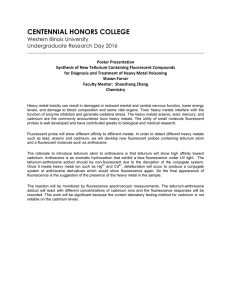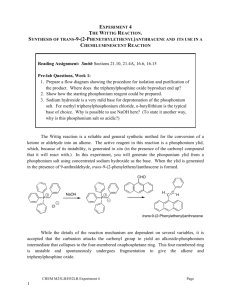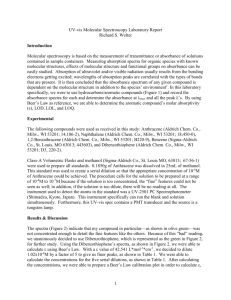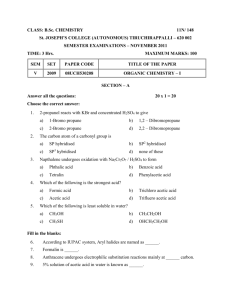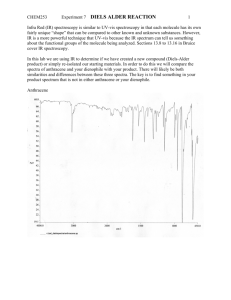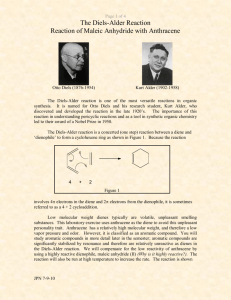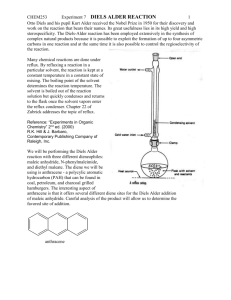Monitoring the dimerization of anthracene using UV-Visible absorbance, fluorescence, and
advertisement
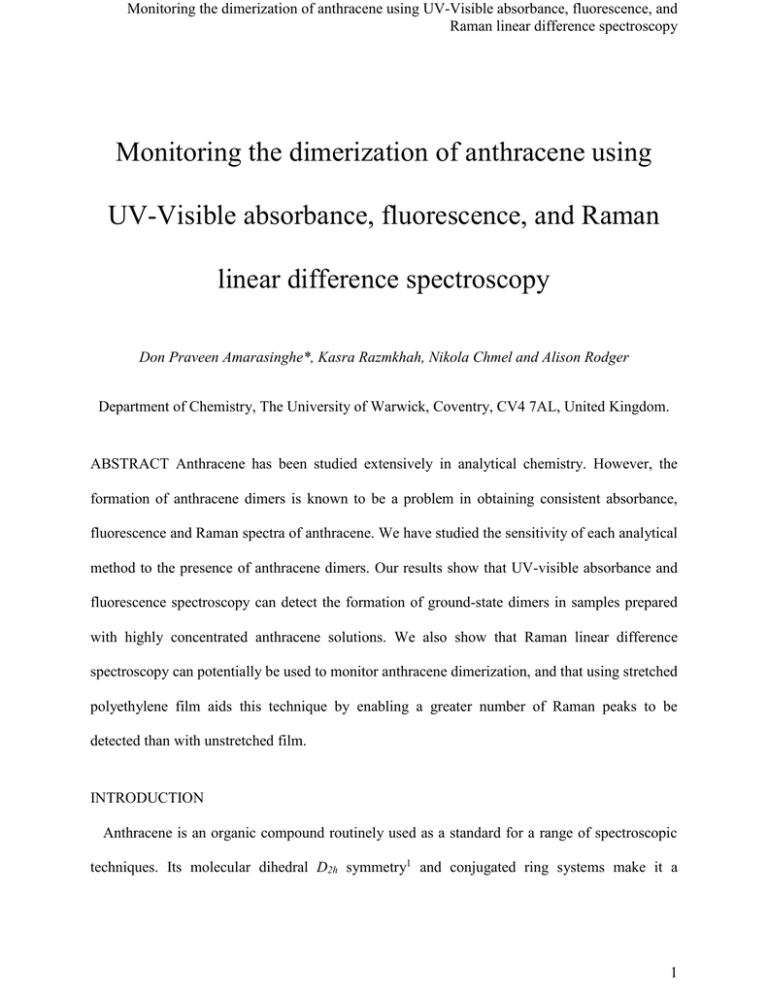
Monitoring the dimerization of anthracene using UV-Visible absorbance, fluorescence, and Raman linear difference spectroscopy Monitoring the dimerization of anthracene using UV-Visible absorbance, fluorescence, and Raman linear difference spectroscopy Don Praveen Amarasinghe*, Kasra Razmkhah, Nikola Chmel and Alison Rodger Department of Chemistry, The University of Warwick, Coventry, CV4 7AL, United Kingdom. ABSTRACT Anthracene has been studied extensively in analytical chemistry. However, the formation of anthracene dimers is known to be a problem in obtaining consistent absorbance, fluorescence and Raman spectra of anthracene. We have studied the sensitivity of each analytical method to the presence of anthracene dimers. Our results show that UV-visible absorbance and fluorescence spectroscopy can detect the formation of ground-state dimers in samples prepared with highly concentrated anthracene solutions. We also show that Raman linear difference spectroscopy can potentially be used to monitor anthracene dimerization, and that using stretched polyethylene film aids this technique by enabling a greater number of Raman peaks to be detected than with unstretched film. INTRODUCTION Anthracene is an organic compound routinely used as a standard for a range of spectroscopic techniques. Its molecular dihedral D2h symmetry1 and conjugated ring systems make it a 1 Monitoring the dimerization of anthracene using UV-Visible absorbance, fluorescence, and Raman linear difference spectroscopy relatively simple but non-trivial compound to analyse. However, in using anthracene as a film linear dichroism standard, we have found large wavelength shifts in the spectra collected with some samples. The formation of dimers or higher order structures in samples of anthracene is known to affect the electronic transition moments of the molecules. The aim of this work was to determine the conditions where it could not be assumed that anthracene was monomeric. The absorption and fluorescence spectra of anthracene and two forms of dimer (a sandwich, with two molecules placed directly on top of one another, and a ground-state dimer, where there is a 55 degree angle between the planes of the molecules) in the near ultra-violet (UV) have already been investigated2-5. These have shown that the presence of dimers (or higher order structures) can result in changes in spectra2. However, there is no evidence to suggest that dimers that form in solutions of anthracene must be one of these two forms. Raman spectroscopy has also been used to analyse anthracene1,6. This technique provides information on the vibrational modes that are specific to the bonds and symmetry of a compound7. While polarised Raman spectra of anthracene have been investigated previously7, dimers of anthracene have not. We have recently developed a technique known as Raman linear difference (RLD) spectroscopy that uses the differences in Raman spectra obtained with parallel and perpendicularly polarised laser light to investigate the alignment of small molecules8. RLD has been used to analyse solutions of anthracene that have been left to dry on polyethylene (PE) films8. This work also proposes aligning anthracene molecules by stretching the PE film either before or after drying anthracene solutions on the surface. We belatedly realised that the concentrations used in the Raman experiments are such that the UV absorbance spectroscopy indicates the presence of dimers or higher order structures. 2 Monitoring the dimerization of anthracene using UV-Visible absorbance, fluorescence, and Raman linear difference spectroscopy The goal of this research is to determine the detection sensitivities of a variety of spectroscopic methods and sample preparation methods to the presence of anthracene dimers. Spectral measurements have been taken of powder samples and solutions of anthracene for a variety of concentrations. Methylcyclohexane (MeCH) solvent has been used to inhibit dimerization through stacking of anthracene molecules. In addition, spectral measurements have been taken of anthracene solutions left to dry on stretched and unstretched PE films, to be compared against each other to determine if using stretched PE film is significantly different. EXPERIMENTAL METHODS Materials and sample preparation Anthracene powder and spectrophotometric grade MeCH from Sigma-Aldrich were used for the preparation of ant. Solutions of anthracene in MeCH were prepared with concentrations of 0.05, 0.1, 0.25, 0.5, 0.8, 1, and 2 mg/ml. PE films, with dimensions of 2 cm by 4 cm, were cut from Glad Snap Lock ® food bags. UV-Visible Absorbance Measurements Measurements were taken using a JASCO® V-660 Spectrophotometer, from 200 nm to 450 nm, using 9 accumulations per measurement. To obtain flat baselines for data comparison, corrections to the data were made using OriginPro® 8.5.1. Samples were prepared in two ways – either as solutions placed in a 10 μm demountable cell or as solutions dried on PE film. For each film sample, a single sheet of PE film was placed and secured in the stretching apparatus, described by Kowalska et al.8, such that the film remained taut but unstretched, the distance between the stretcher clamps was 2.5 cm, and the “grain” of the film was perpendicular to both clamps. Spectral measurements were taken with the film in the stretching apparatus. A droplet of 30 μl anthracene solution was then left to dry on the film. The film was then stretched to from 2.5 cm to 4.5 cm. Spectral measurements of the sample were 3 Monitoring the dimerization of anthracene using UV-Visible absorbance, fluorescence, and Raman linear difference spectroscopy taken before and after this stretching. Measurements were taken with the stretching apparatus placed so that the light beam would pass through the film to the detector unobstructed. Fluorescence Measurements Fluorescence between 220 nm and 550 nm was measured using a JASCO® FP-6500 Spectrofluorometer. Solutions were placed in a 5mm diameter quartz cuvette. Each measurement was composed of 9 accumulations. To enable changes in relative fluorescence intensities between concentrations of anthracene solution to be observed, excluding fluorescence data generated with an excitation wavelength of 395 nm, the spectra were normalised using OriginPro® 8.5.1 so that the area under the four peaks between 360 nm and 500 nm was one. For spectra where an excitation wavelength of 395 nm was used, to avoid including the peak at 395 nm (corresponding to the excitation radiation), the data were normalised so that the area under the peaks between the point separating the peaks at 395 nm and 400 nm, and 500 nm was one. Raman Measurements Powder samples were prepared by placing a few anthracene granules on a quartz slide. Solution samples were prepared by leaving a 30 micro litre drop of solution to evaporate on the slide. Film samples were prepared with the film in an unstretched or stretched position. Unstretched films were constructed from a single sheet of PE film placed and secured in the stretching apparatus described previously8, such that the film remained taut but unstretched, the distance between the stretcher clamps was 2.5 cm, and the “grain” of the film was perpendicular to both clamps. Stretched film samples were prepared in the same way, but with the film subsequently stretched from 2.5 cm to 4.5 cm. In both cases, spectral measurements were taken before and after application of a droplet of 30 μl anthracene solution left to dry on the film. Two polarised Raman spectra were recorded for each sample - one using incident radiation parallel to the PE stretch direction or the longest edge of the quartz slide and one perpendicular. 4 Monitoring the dimerization of anthracene using UV-Visible absorbance, fluorescence, and Raman linear difference spectroscopy The spectra were recorded using a Renishaw® inVia Raman Microscope, equipped with a Renishaw® 633 nm laser, a 1800 lines/nm diffraction grating and a Renishaw® charged coupled device detector. Measurements were taken in “extended mode”, from 200nm to 450nm, with an exposure time of 10 seconds and 50% laser power (except for an anthracene powder sample, where 10% was used). 50 accumulations were collected, with 3 hidden accumulations used for cosmic ray removal. To obtain flat baselines for data comparison, corrections to the data were made using OriginPro® 8.5.1. RESULTS Absorbance of UV-Vis radiation Data collected from absorbance measurements of anthracene solutions (Figure 1, and in the supporting information, Table S-1 and Figure S-2) satisfy the Beer-Lambert law at 253 nm, with the exception of the 2 mg/ml solution, with ε253 = 443630 M-1cm-1. There is a small peak shift in the long wavelength absorbance bands, with the 253 nm peak shifting to 251.4 nm for the highest solution concentration. Data collected from experiments with the PE film matrices (Figure 2 and, in the supporting information, Figure S-1) show the appearance of peaks at 395 nm with higher concentrations of anthracene solution. There is also the formation of a shoulder at 263 nm, indicated by the nonzero decreasing absorbance of the more concentrated solutions and zero absorbance for lower solution concentrations around 263 nm. With the exception of the spectrum for the 2 mg/ml solution, there is a pattern of increasing absorbance with increasing concentration. The use of stretched PE film appears to result in more distinct absorbance spectra. This is particularly noticeable in the peaks at 255 nm for 0.5 mg/ml, 0.8 mg/ml and 1 mg/ml, where separation is more prevalent with stretched PE (Figure 2) than with unstretched PE (Figure S-1). Absorbance 5 Monitoring the dimerization of anthracene using UV-Visible absorbance, fluorescence, and Raman linear difference spectroscopy intensities for solutions with 0.05 mg/ml and 0.1 mg/ml concentration also appear to be distinctly lower than for solutions with higher concentrations. 2 mg/ml 1 mg/ml 0.8 mg/ml 0.5 mg/ml 0.25 mg/ml 0.1 mg/ml 0.05 mg/ml 3.5 3.0 0.25 0.20 Absorbance Absorbance 2.5 2.0 1.5 1.0 2 mg/ml 1 mg/ml 0.8 mg/ml 0.5 mg/ml 0.25 mg/ml 0.1 mg/ml 0.05 mg/ml 0.15 0.10 0.05 0.5 0.0 0.00 -0.5 200 220 240 260 280 300 320 Wavelength (nm) 340 360 380 400 Wavelength (nm) Figure 1. Short wavelength (left) and long wavelength (right) UV-visible radiation absorbance spectra of anthracene solutions of different concentrations as indicated in the figure. 2 mg/ml 1 mg/ml 0.8 mg/ml 0.5 mg/ml 0.25 mg/ml 0.1 mg/ml 0.05 mg/ml 1.4 1.2 0.8 0.06 0.05 0.04 Absorbance Absorbance 1.0 0.6 0.4 0.03 0.02 0.2 0.01 0.0 0.00 -0.2 2 mg/ml 1 mg/ml 0.8 mg/ml 0.5 mg/ml 0.25 mg/ml 0.1 mg/ml 0.05 mg/ml -0.01 200 220 240 260 Wavelength (nm) 280 300 300 320 340 360 380 400 420 440 Wavelength (nm) Figure 2. Short wavelength (left) and long wavelength (right) UV-visible radiation absorbance spectra of anthracene solutions of different concentrations left to dry on unstretched, taut polyethylene film and with the film subsequently stretched to 1.8 times its original length. Fluorescence spectra Wavelengths of excitation radiation used for obtaining fluorescence data were chosen from the wavelengths peaks in the absorbance spectra. Fluorescence spectra for 6 Monitoring the dimerization of anthracene using UV-Visible absorbance, fluorescence, and Raman linear difference spectroscopy excitation wavelengths of 252 nm, 263 nm, and 395 nm appear in Figure 3. These wavelengths correspond to wavelengths at which peaks appear in the absorbance spectra for all solution concentrations (252 nm), or for higher concentrations only (263 nm and 395nm) potentially indicating the presence of anthracene dimers. Fluorescence spectra for other excitation wavelengths appear in Figures S-3 to S-8 in the supporting information. In all fluorescence spectra, the area-normalised intensities (See Experimental Methods section) between different concentrations of anthracene solution do not vary significantly from each other at 400 nm, 423 nm and 449 nm. Furthermore, there is also a shrinking peak that moves from 383 nm to 390 nm as the concentration is increased. The spectra generated using an excitation wavelength of 263 nm display peaks at 303 nm, 312 nm, 328 nm and 343 nm for lower solution concentration, whereas higher solution concentrations do not fluoresce at these wavelengths. 0.5 0.02 0.03 0.02 0.01 0.01 350 400 450 500 550 250 0.3 0.2 0.1 0.00 0.00 0.05 mg/ml 0.1 mg/ml 0.25 mg/ml 0.5 mg/ml 0.8 mg/ml 1 mg/ml 2 mg/ml 0.4 Fluorescence Fluorescence 0.03 0.05 mg/ml 0.1 mg/ml 0.25 mg/ml 0.5 mg/ml 0.8 mg/ml 1 mg/ml 2 mg/ml 0.04 Fluorescence 0.05 mg/ml 0.1 mg/ml 0.25 mg/ml 0.5 mg/ml 0.8 mg/ml 1 mg/ml 2 mg/ml 0.04 0.0 300 Wavelength (nm) 350 400 450 Wavelength (nm) 500 550 340 360 380 400 420 440 460 480 500 520 Wavelength (nm) Figure 3. Fluorescence spectra of anthracene solutions of different concentrations, with the wavelength of excitation radiation set at 252 nm (left), 263 nm (centre) and 395 nm (right). Fluorescence intensities have been normalised by area for comparison. The tall peaks in the 395 nm spectra are from the excitation radiation. Raman spectra Raman linear difference (RLD) spectra for samples of stretched and unstretched PE films with and without dried anthracene solutions were obtained by subtracting the spectrum measured using radiation perpendicular to the stretch direction of the film from the 7 Monitoring the dimerization of anthracene using UV-Visible absorbance, fluorescence, and Raman linear difference spectroscopy spectrum measured using radiation parallel to the stretch direction. Raman linear sum (RLS) spectra for samples of anthracene powder on quartz slides, dried anthracene solutions on quartz slides and on PE films were obtained by taking an average of the spectra measured using radiation perpendicular and parallel to the stretch direction of the PE or the longest side of the quartz slide. Figure S-9 in the supporting information displays the RLS spectra for anthracene crystals formed from leaving solutions with concentrations 2 mg/ml and 0.5 mg/ml to dry on a quartz slide. The major difference between the two spectra is the noise prevalent in the spectrum for the 0.5 mg/ml solution. However, it is still possible to identify small peaks in both spectra that do correspond with peaks observed in the RLS for powder (Figure 4, black line). The wavenumbers of these peaks are listed in Table S-2 in the supporting information. 8 Monitoring the dimerization of anthracene using UV-Visible absorbance, fluorescence, and Raman linear difference spectroscopy RLS - Powder RLS - 2 mg/ml Anthracene on 1.8x Stretched PE RLD - 0.5 mg/ml Anthracene on 1.8x Stretched PE RLD - 2 mg/ml Anthracene on 1.8x Stretched PE 0 500 1000 1500 2000 2500 3000 3500 Wavenumber (cm-1) Figure 4. Raman linear sum spectra of anthracene powder (black) and anthracene crystals formed from drying 2 mg/ml anthracene in MeCH solution on PE film stretched to 1.8 times its length, and Raman linear difference spectra of anthracene crystals formed from drying 0.5 mg/ml (magenta) and 2 mg/ml (blue) anthracene solutions on stretched PE film. Raman intensities are not to scale. Stretching PE does result in small changes to the relative intensities of peaks in the RLS spectra of PE film (Figure S-10), but the effects are more prominently displayed in the RLD spectra of stretched and unstretched PE film (Figure S-12), where peaks, such as at around 1417 cm-1 and 2882 cm-1 change sign. Stretched PE film also enabled more peaks in anthracene samples to be identified for both RLS and RLD spectra, as demonstrated by the data collated in 9 Monitoring the dimerization of anthracene using UV-Visible absorbance, fluorescence, and Raman linear difference spectroscopy Table S-2. This is also shown in the RLS spectra of dried anthracene solutions on stretched and unstretched PE films (Figure 1, red line, and Figure S-11) - even when peaks attributed to PE (identified using the spectra in Figure S-10) are omitted, there are more distinguishable peaks seen when stretched PE film is used than with unstretched. There are a small number of differences between the RLD spectra of anthracene samples prepared on unstretched film using 0.5 mg/ml and 2 mg/ml solutions (Table S-2). Peaks at around 1557 cm-1, 1163 cm-1, and 752 cm-1 changed from positive with 0.5 mg/ml solution to negative with 2 mg/ml solution. However, peaks around 1557 cm-1 and 1163 cm-1 were not found in the RLD spectrum for 2 mg/ml anthracene solution on stretched PE film, and there is no sign change for the peaks around 752 cm-1 between the RLD spectra of 0.5 mg/ml and 2 mg/ml solutions dried on stretched PE film. Conversely, the RLD spectra of samples prepared on stretched film (Figure 4, magenta and blue lines, and Table S-2) also have peak sign changes at 1480 cm-1 and 1008 cm-1, both from negative with 0.5 mg/ml to positive with 2 mg/ml. But peaks around 1480 cm-1 and 1008 cm-1 were not detected in the RLD spectrum for either unstretched PE film sample. DISCUSSION All of the analytical techniques used have depicted differences in anthracene samples prepared using anthracene solutions of different concentrations. The next step is to assess if these differences indicate the formation of anthracene dimers. Peaks at 395 nm in data from UVvisible absorbance spectroscopy of more concentrated solutions dried on PE film could be attributed to the formation of ground-state dimers2,4. There is also evidence4 to suggest that higher order structures are being formed. In contrast, while studies of long axis electronic 10 Monitoring the dimerization of anthracene using UV-Visible absorbance, fluorescence, and Raman linear difference spectroscopy transitions giving rise to short wavelength absorbance exist in the literature4,9, there is no evidence available to link the formation of either sandwich dimers or ground-state dimers with absorbance spectrum peaks at 263 nm. It is possible that the appearance of these peaks with higher concentrations of anthracene solution could be linked to a new form dimer not previously considered. However, the experiments of Chandross et al.2 should be repeated, with analysis of the long axis electronic transitions, to eliminate the possibility that these peaks are due to sandwich or ground-state dimers. A criticism of the absorbance data is the comparatively noisy and inconsistent data for samples prepared with 2 mg/ml solution, such as that seen in the long wavelength absorbance data (Figures 2 and S-1) and the outlier in the Beer-Lambert law calculations (Table S-1). Although 2mg/ml is under the known10 maximum concentration achievable at room temperature and pressure of 2.3 mg/ml, there were problems in preventing the precipitation of anthracene out of the solution. Since this is a concern that will affect the preparation and analysis (not just with absorbance spectroscopy) of samples derived from highly concentrated solutions of anthracene, protocols in the handling of such solutions to avoid changes in concentration will need to be considered in future. The peak shift observed in the fluorescence spectroscopy results can also be attributed to the formation of ground-state dimers with the use of higher concentrations of anthracene solution. Chandross et al2 displays fluorescence data where the lowest wavelengths from anthracene monomer fluorescence and ground-state dimer fluorescence were detected at around 380 nm and 390 nm respectively - consistent with the peak shift from 383 nm to 390 nm seen in Figure 3. However, the changes in peak intensity between 303 nm and 343 nm found in the fluorescence spectra obtained using 263 nm excitation radiation cannot be attributed to anthracene, the 11 Monitoring the dimerization of anthracene using UV-Visible absorbance, fluorescence, and Raman linear difference spectroscopy sandwich dimer or the ground-state dimer, and there does not appear to be any straightforward explanation for their appearance in the spectra. The RLS data that we have obtained is consistent with previously published data on the Raman spectroscopy of anthracene1,6. However, as can be seen in Figure S-9, data obtained with samples prepared using 0.5 mg/ml solution are more noisy, due to the difficulty in detecting smaller amounts of anthracene. Obtaining Raman spectra with more accumulations will rectify this problem. It was also hoped that the RLD data would help to distinguish between PE film samples prepared using two different concentration of anthracene solution – any changes in the sign of peaks would indicate a change in the orientation of anthracene molecules on the film, suggesting the formation of dimers. The presence of peak sign changes in the RLD data between solution concentrations does suggest that this might still be case. However, the fact that peak sign changes at 1557 cm-1 (C-C in plane stretching1), 1480 cm-1 (C-C in plane stretching1), 1163 cm-1 (C-H in plane bending1) and 1008 cm-1 (C-H in plane bending1) did not occur for both unstretched and stretched PE films does pose the question of how reliable the peak sign changes are. This is also a concern with regard to the RLD peaks at 752 cm-1 corresponding to C-C bending in plane1 – whereas the peak underwent a sign change with unstretched PE film, the corresponding RLD peaks with stretched film did not. The use of stretched PE films in contrast to unstretched films has, however, enabled the detection of more Raman spectrum peaks. This can be attributed to the alignment of PE molecules and of anthracene molecules on film as it is stretched, as described in earlier work8 and displayed in the changes in the signs of peaks in RLD spectra of unstretched and stretched PE films (Figure S-10). The use of PE films to orient molecules may also explain the distinct difference in absorbance intensities for samples on PE film prepared using 0.05 mg/ml and 0.1 12 Monitoring the dimerization of anthracene using UV-Visible absorbance, fluorescence, and Raman linear difference spectroscopy mg/ml and samples prepared using higher concentrations (Figures 2 and S-1). This is in contrast with the roughly linear relationship between absorbance and solution concentration when samples consist of anthracene solution alone (Figure 1). This could be evidence of PE film assisting in the alignment of anthracene molecules in a way that promotes the formation of dimers and higher order structures. To confirm this, further absorbance data would need to be collected on samples prepared using solutions with concentrations between 0.1 and 0.25 mg/ml. This would also help to assess if there is a transition point where there are enough anthracene molecules on the film to trigger dimer formation. CONCLUSIONS We have illustrated the use of three analytical methods to study anthracene as a powder, dissolved in methylcyclohexane, and as crystals formed from leaving anthracene solutions to dry on quartz slides and on PE film. Data from UV-visible absorbance spectroscopy and fluorescence spectroscopy provide some indication of the formation of ground-state dimers in high concentrations of solutions of anthracene in MeCH. The use of RLD and PE film to monitor the formation of dimers still needs to be investigated further, as data we have obtained are inconsistent in displaying changes in the alignment of anthracene molecules on PE film. However, the use of stretched PE film does aid the detection of a greater number of RLS and RLD peaks. ASSOCIATED CONTENT Supporting Information UV-visible absorbance spectra of solutions of anthracene left to dry on unstretched PE film; Absorbance data of anthracene solutions at 253 nm; A plot of 13 Monitoring the dimerization of anthracene using UV-Visible absorbance, fluorescence, and Raman linear difference spectroscopy absorbance at 253 nm against concentration of anthracene solution; Fluorescence spectra of solutions of anthracene in methylcyclohexane at excitation wavelengths of 247.5 nm, 252 nm, 263 nm, 324 nm, 340 nm, 354 nm, 363 nm, 377 nm and 395 nm; RLS spectra of anthracene solutions dried on quartz slides; RLS spectra of stretched and unstretched PE film; RLS spectra of anthracene solutions dried on unstretched and stretched PE film; RLD spectra of unstretched and stretched PE film; Table of anthracene peaks identified in RLS and RLD spectra. This material is available free of charge via the Internet at http://pubs.acs.org. AUTHOR INFORMATION Corresponding Author *Email: d.p.amarasinghe@warwick.ac.uk Author Contributions The manuscript was written through contributions of all authors. All authors have given approval to the final version of the manuscript. ACKNOWLEDGMENTS The authors are grateful to the Engineering and Physical Sciences Research Council for funding of this research, through the Molecular Organisation and Assembly in Cells Doctoral Training Centre at the University of Warwick. The Renishaw® Raman spectroscopy equipment used was obtained through the Birmingham Science City Advanced Materials project “Creating and Characterizing Next Generation Advanced Materials". ABBREVIATIONS 14 Monitoring the dimerization of anthracene using UV-Visible absorbance, fluorescence, and Raman linear difference spectroscopy MeCH, Methylcyclohexane; PE, Polyethylene; RLD, Raman linear difference; RLS, Raman linear sum; UV, ultra-violet. REFERENCES (1) Abasbegović, N.; Vukotić, N.; Colombo, L. J. Chem. Phys. 1964, 41 (9), 2575−2577. (2) Chandross, E. A.; Ferguson, J.; McRae, E. G. J. Chem. Phys. 1966, 45 (10), 3546−3553. (3) Ferguson, J.; Mau A. W. H.; Morris, J. M. Aust. J. Chem. 1973, 26 (1), 91−102. (4) Ferguson, J.; Mau A. W. H.; Morris, J. M. Aust. J. Chem. 1973, 26 (1), 103−110. (5) Wright G. T. Phys. Rev. 1995, 100 (2), 587−588. (6) Räsänen, J.; Stenman, F.; Penttinen, E. Spectrochim. Acta, Part A 1973, 29 (2), 395−403. (7) Ferraro, J. R.; Nakamoto, K. Introductory Raman Spectroscopy, 1st Ed.; Academic Press Limited: London, 1994. (8) Kowalska, P.; Cheeseman, J. R.; Razmkhah, K.; Green, B.; Nafie, L. A.; Rodger, A. Anal. Chem. 2012, 84, 1394−1401. (9) Friedrich D. M.; Mathies R.; Albrecht A. C. J. Molec. Spect. 1974, 51, 166−188. (10) Tucker, S. A.; Acree, W. E. , Jr. Phys. Chem. Liq. 1989, 20, 31−38. 15
